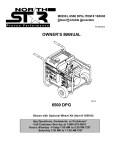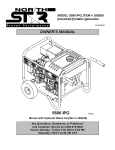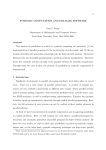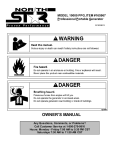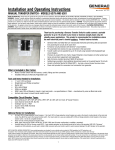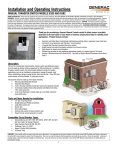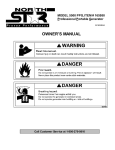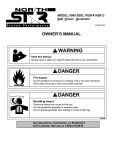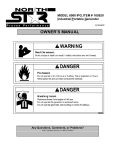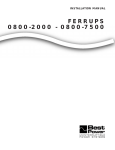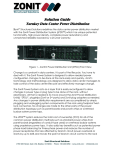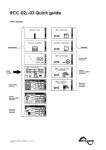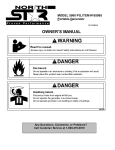Download Northern Industrial Tools 15000 PPG User's Manual
Transcript
MODEL 15000 PPG, ITEM #165925 Professional Portable Generator Pr o ve n M165925A Pe r f or ma n ce OWNER’S MANUAL 00211 Shown with Wheel Kit (Item # 165919) Any Questions, Comments, or Problems? Call Customer Service at 1-800-270-0810 Hours: Monday - Friday 7:30 AM to 5:30 PM CST THANK YOU Thank you for purchasing a North Star Pro Series Generator. Your machine is designed for long life, dependability, and the top performance you demand. Please take time now to read through this manual so you can better understand the machine’s operation, maintenance and safety precautions. Everyone who operates this generator must read and understand this manual. The time you take now will prolong your generator’s life and prepare you for its safe operation. Enjoy the exceptional performance of your North Star Pro Series Generator. IMPORTANT Make certain the operator: - Reads and understands the manuals pertaining to this machine. - Is instructed in safe and proper operation of this machine. NOTICE K-BAR Industries Incorporated reserves the right to make improvements in design and/or changes in specifications at any time without incurring any obligation to install them on units previously sold. TABLE OF CONTENTS Thank you Specifications Machine component identification Generator features Introduction ANSI safety definitions Rules for safe operation Installation Load application Pre-start up preparation Starting Stopping Engine care Generator care Troubleshooting 1 2 3 4 4-5 5 5 5-6 6-7 7-8 8 8 8 8 9 1 SPECIFICATIONS Item Number Maximum Output Continuous Output Voltage Phase Frequency Power Factor Total Harmonic Distortion Engine Engine Speed Fuel Type Fuel Capacity Oil Capacity Starting Method 120V Receptacles 120/240V Receptacles Circuit Breakers Battery #165925 15000 Watts (W) 13500 Watts (W) 120/240 Volt (V) Single phase (4-wire) 60.0-62.5 Hertz (Hz) 1.0 p.f. less than 8% 25 HP Kohler Command 3600-3750 RPM Unleaded gasoline 10 gallons (38.0 L) 2.1 US quarts with filter Electric start 2 - 20 Amp (A) duplex (NEMA 5-20R) 30 Amp (A) twistlock (NEMA L5-30R) 30 Amp (A) twistlock (NEMA L14-30R) 60 Amp (A) straight blade (NEMA 14-60R) 60 Amp (A) thermal magnetic 30 Amp (A) thermal magnetic 30 Amp (A) thermal, push to reset 2 - 20 Amp (A) thermal, push to reset 12V DC 380 cca, shipped dry, add electrolyte to fill line on each cell. Dimensions Length Width Height Dry Weight Gross Weight 35.75” (90.8 24.25” (61.6 26.25” (66.7 425 lb (193 495 lb (225 2 cm) cm) cm) kg) kg) MACHINE COMPONENT IDENTIFICATION Figure 1 (Ref. 1-10) Ref. 1 2 3 4 5 6 7 8 9 10 Description Ref. Air Cleaner Circuit Breakers 120/240V, 60A Receptacle 120/240V, 30A Twistlock Rec. 120V, 30A Twistlock Rec. 120V, 20A Duplex Rec. Oil Drain Valve Vibration Isolation Mount Starting/Stopping Instructions Wheel Kit (#165919) 11 12 13 14 15 16 17 18 19 20 Figure 2 (Ref. 11-20) 3 00212 Description 10.0 Gallon Gas Tank Engine Key Choke Muffler & Spark Arrestor Oil Filter Battery Box & Battery Gas Line Valve Generator Head Gas Drain Valve Gas Cap with Gauge 00213 Reference 13 - Choke Lever. Used during cold starts. Refer to the starting/stopping instructions and the Kohler Command 25 engine manual for usage. Reference 14 - Muffler and Spark Arrestor. Reference 15 - Oil Filter. Kohler oil filter number 12-050-01 or equivalent. Reference 16 - Battery Box and Battery. Battery is shipped without electrolyte. Fill each battery cell to the fill line with locally purchased electrolyte (sulfuric acid and water). GENERATOR FEATURES Reference 1 - Air Cleaner. Refer to your Kohler engine manual for air cleaner care. Reference 2 - Circuit Breakers. This portable single phase generator has 1 - 60 amp (A) thermal magnetic 2 pole breaker, 1 - 30 amp (A) thermal magnetic 2 pole breaker 1 - 30 amp (A) push to reset circuit breaker, and 2 - 20 amp (A) push to reset circuit breakers. Circuit breakers protect against electrical overloads. Reference 3 - 120/240V Receptacle. This receptacle is a 120/240V 60A NEMA 14-60R receptacle. This receptacle accepts a NEMA plug number 14-60P, which is supplied with the generator. Use this receptacle if installing a transfer switch. Compatible with Gentran transfer switch, item #164117. Reference 4 - 120/240V Tw istlock Receptacle. This twistlock is a 120/240V 30A NEMA L14-30R receptacle. This receptacle accepts a NEMA plug number L14-30P, which is supplied with the generator. Reference 5 - 120V Twistlock Receptacle. This twistlock is a 120V 30A NEMA L5-30R receptacle. This receptacle accepts a NEMA plug number L5-30P, which is supplied with the generator. Reference 6 - 120V Receptacle. The generator has a control panel with two duplex (two receptacles in a common housing) receptacles. Each duplex is a 120 volt (V) 20 amp (A) straight blade receptacle, National Electrical Manufacturer’s Association (NEMA) number 5-20R. This receptacle accepts NEMA plug numbers 5-15P and 5-20P. Each duplex is capable of drawing 20A at 120V. ALWAYS use grounded male plugs. The neutral line of the generator is mechanically grounded to the frame. Matching NEMA male plugs must always be used. WARNING Sulfuric acid is a corrosive poison. Avoid contact with skin, eyes or clothing. Reference 17 - Gas Line Valve. The generator tank has an ON-OFF valve mounted underneath the tank. Always keep this valve closed when the generator is not in use. Reference 18 - Generator Head. The electricity producing part of the generator. Reference 19 - Gas Drain Valve. The generator is equipped with a unique feature. A gas drain valve is installed to drain gasoline from the tank without disconnecting the gas line feeding the engine. This valve is intended to be used to drain gas prior to extended periods of non use. It is recommended that if the period of non use is longer than 30 days, the gas should be drained, and the engine run until all the gas is evacuated from the carburetor. ALWAYS make sure this valve is closed prior to filling the gas tank. Reference 20 - Gas Cap w ith Gauge. The gas cap is extra large, creating a large hole for refilling and a comfortable grip. You can always monitor the fuel level without removing the cap by using the fuel level indicator built into the gas cap. Low Oil Shutdow n. The Kohler engine is protected against damage resulting from low oil level. As the oil falls below the safe level, the engine automatically shuts off (the engine stop switch remains in the on position). The engine will not start until the oil is refilled to above the safe level. WARNING Contact a licensed electrician to wire electrical plugs and/or cordsets. Improper wiring could result in a fire or electrical shock. Reference 7 - Oil Drain Valve. Refer to your Kohler engine manual for oil change recommendations. Reference 8 - Vibration Isolation Mounts. The engine and generator head are mounted on rubber cylinders that absorb most of the engine vibration. This feature eliminates the tendency of the machine to “walk” which is common in engine powered equipment. Reference 9 - Starting/Stopping Instructions. Reference 10 - Wheel Kit. Heavy duty wheel kit (Item # 165919). Reference 11 - 10.0 Gallon Gas Tank. Large tank allows for extended run capabilities. Alw ays allow room for gasoline expansion by not filling the gas tank completely full. Reference 12 - Engine Key. The engine key switch is located on the front of the engine. Always locate this switch and be familiar with its location before operating the generator. INTRODUCTION Before starting your generator, thoroughly study the instructions and cautions in this manual to assure you are fully acquainted with the operation of all components of this generator. Proper preparation, operation and maintenance will result in operator safety, best performance and long life of the generator. For detailed engine operation and maintenance always refer to the Kohler engine owner’s manual furnished with the generator. North Star is constantly improving its products. The specifications outlined herein are subject to change without prior notice or obligation. The purchaser and/or user assumes liability of any modification and/or alterations on this equipment from original design and manufacture. Before using, the user shall determine the suitability of this product for its intended use and assumes liability therein. 4 NEVER touch hot muffler, hot exhaust manifold or engine cooling fins. ANSI SAFETY DEFINITIONS ALWAYS remove all oil or gasoline deposits and accumulated dirt from generator and immediate area. Keep generator head and engine clean. DANGER indicates an imminently hazardous situation which, if not avoided, will result in death or serious injury. This signal word is to be limited to the most extreme situations. NEVER operate the generator under the following conditions: A. Excessive change in engine speed, slow or fast. B. Overheating in load connecting devices. C. Sparking or arcs from generator. D. Loss of electrical output. E. Damaged receptacles. F. Engine misfire. G. Excessive vibration. H. Enclosed compartments or confined areas. I. Flame or smoke. J. Rain, snow or wet conditions. K. Operator non-attendance. WARNING indicates a potentially hazardous situation which, if not avoided, could result in a death or serious injury. CAUTION indicates a potentially hazardous situation, which if not avoided, may result in minor or moderate injury. It may also be used to alert against unsafe practices. RULES FOR SAFE OPERATIONS Safety precautions are essential when operating this generator. Respectful and cautious operation will considerably lessen the possibilities of a personal injury. This manual will warn of specific personal injury potential, and these will be designated by the symbol: WARNING Check fuel system on a regular basis. Look for signs of leaks, deterioration, chafed or spongy fuel hose, loose or missing fuel hose clamps, damaged fuel tank or a defective fuel shut-off valve. Correct any defects before operation. WARNING Keep fire extinguisher close by your generator and be familiar on how to use it. Consult your local fire department for correct extinguisher type. WARNING This generator is equipped with a grounding screw, located on the generator head for your protection. Always complete the grounding path from the generator to a copper pipe/rod that is driven into moist earth, to prevent electrical shock. INSTALLATION OUTDOORS: Choose a location where the generator will not be exposed to rain, snow or direct sunlight. Position the generator on secure, level ground so it will not tip or slide down a hill. Place the generator so that the exhaust fumes will not be directed towards people. The installation site must be free from water, moisture, or dust. All electrical components should be protected from excessive moisture or the insulation system will deteriorate and result in grounding or shorting out the generating system. Foreign matters, such as dust, dirt, sand, lint, or abrasive materials can cause damage to the generator head and engine if allowed into its cooling system. NEVER install your generator inside confined areas. Inside installation can cause health hazards or death. ALWAYS use electrical cords that are in good condition. Worn, bare, frayed or otherwise damaged cords can cause electric shock. NEVER operate the generator, or handle any electrical equipment while standing in water, while barefoot, while hands are wet or while in the rain or snow. Electric shock may result. ALWAYS use a ground fault circuit interrupter (GFCI) in damp or highly electrical conductive areas and on construction job-sites to prevent electric shock. ALWAYS remove the spark plug or spark plug wire before working on the engine or generator, to prevent accidental starting. ALWAYS provide adequate ventilation. Do not operate generator in any enclosed or narrow space. Engines consume oxygen and give off deadly carbon monoxide poisonous gas. Improper ventilation will cause damage to generator and possible injury to people. DANGER Remember, exhaust fumes are deadly carbon monoxide gas, and must be vented to the outside where there are no people. Cooling air of sufficient amounts must be allowed to flow in and exhausted out to ensure proper cooling of the engine and generator head. 5 120V, 60 Hz Motors Hp motor Running Watts 1/6 525 1/4 700 1/3 875 1/2 1175 1 1925 1 1/2 2400 2 2900 3 4075 5 6750 LOAD APPLICATION It is important to determine the total electrical load before it is connected to the generator. The two major factors in determining the life of a generator head are: heat build up, caused by overloading the generator and corrosive contaminants, that attack the wiring insulation. If the generator is overloaded, the wires become excessively hot and cause the insulation to break down, reducing its ability to resist corrosive contaminants. Over time the effectiveness of the insulation is eliminated and a dead short can result. Always compare the generator nameplate data with that of the equipment to be used to ensure that watts, volts, amperage, and frequency requirements are suitable for operating equipment. The wattage listed on the equipment nameplate is its rated output. However, some equipment may require three to ten times more wattage than its rating on the nameplate, as the wattage is influenced by the equipment efficiency, power factor and starting system. NOTE: If wattage is not given on equipment nameplate, approximate wattage may be determined by multiplying nameplate voltage by nameplate amperage. RI type 7-11 9-15 11-18 15-25 24-40 30-50 36-60 51-85 84-140 Starting Amps Cap type SP type 9-18 12-23 14-29 20-40 32-64 40-80 48-96 68-136 112-224 16-22 22-32 26-35 NA NA NA NA NA NA The figures given above are for an average load such as a blower or fan. If the electric motor is connected to a hard starting load, such as an air compressor, it will require more starting current. If it is connected to a light load, or no load, such as a power saw, it will require less starting current. The exact requirement will also vary with the brand or design of the motor. Generators respond to severe overloading differently than the power line. When overloaded, the engine is not able to supply enough power to bring the electric motor up to operating speed. The generator responds to the high initial starting current, but the engine speed drops sharply. The overload may stall the engine. If allowed to operate at very low speeds, the electric motor starting winding will burn out in a short time. The generator head winding might also be damaged. Running the generator under these conditions may result in damage to the generator stator as well as the motor windings. Because the heavy surge of current is required for only an instant, the generator will not be damaged if it can bring the motor up to speed in a few seconds. If difficulties in starting a motor are experienced, turn off all other electrical loads and if possible reduce the load on the electric motor. VOLTS X AMPS = WATTS Example: 120V X 5A = 600W When connecting a resistive load such as incandescent lights, heaters or common electric power tools, a capacity of up to the generator full rated wattage output can be used. When connecting a resistive-inductive load such as a fluorescent or mercury light, transformers or inductive coils, a capacity of up to 0.6 times the generator’s full rated output can be used. Always allow the generator to reach operating speed before a load is applied. EXTENSION CORDS STARTING ELECTRIC MOTORS When electric power is to be provided to various loads at some distance from the generator, extension cords can be used. These cords should be sized to allow for distance in length and amperage so that the voltage drop between the set and point of use is held to a minimum. Current/Pow er Maximum Extension Cord Length Amps Load #10 #12 #14 #16 at (watts) Ga. Ga. Ga. Ga. 240V Cord Cord Cord Cord 10 2400 250’ 150’ 100’ 75’ 20 4800 125’ 75’ 50’ 25’ 30 7200 60’ 35’ 25’ 10’ 40 9600 30’ 15’ 10’ * 50 12000 15’ * * * *Not recommended CAUTION: Equipment damage can result from the low voltage caused by using an extension cord with a small wire size. Electric motors require much more current (amps) to start than to run. Some motors, particularly low cost split-phase motors, are very hard to start and require 5 to 7 times more current to start than to run. Capacitor motors are easier to start and usually require 2 to 4 times as much current to start as to run. Repulsion Induction motors are the easiest to start and require 1.5 to 2.5 times as much to start as to run. Most fractional motors take about the same amount of current to run them whether they are of Repulsion-Induction (RI), Capacitor (Cap), or SplitPhase (SP) type. The following chart shows the approximate current required to start and run various types and sizes of 120 volt 60 cycle electric motors under various conditions. 6 NOTE: For extremely hard to start loads such as air conditioners and air compressors, consult the equipment dealer to determine the maximum wattage. Use this chart to estimate the total load on your generator. For Determining Generator Load Requirements Dev ice Running Watts Air Conditioner (12,000 Btu) 1700 (a) Battery Charger (20 Amp) 500 Belt Sander (3”) 1000 Chain Saw 1200 Circular Saw (6-1/2”) 900 Coffee Maker 1000 Compressor (1 HP) 2000 (a) Compressor (3/4 HP) 1800 (a) Compressor (1/2 HP) 1400 (a) Curling Iron 700 Dishwasher 1200 Edge Trimmer 500 Electric Nail Gun 1200 Electric Range (one element) 1500 Electric Skillet 1250 Furnace Fan (1/3 HP) 1200 (a) Freezer 800 (b) Hair Dryer 1200 Hand Drill (1”) 1100 Hand Drill (1/2”) 875 Hand Drill (3/8”) 500 Hand Drill (1/4”) 250 Hedge Trimmer 450 Home Computer 150 Impact Wrench 500 Jet Pump 800 Lawn Mower 1200 Light Bulb 100 Microwave Oven 700 Milk Cooler 1100 (a) Oil Burner on Furnace 300 Oil Fired Space Htr (140,000 Btu) 400 Oil Fired Space Htr (85,000 Btu) 225 Oil Fired Space Htr (30,000 Btu) 150 Oven 4500 Paint Sprayer, Airless (1/3 HP) 600 (a) Paint Sprayer, Airless (handheld) 150 Radio 200 Refrigerator 600 (b) Slow Cooker 200 Submersible Pump (1-1/2 HP) 2800 (a) Submersible Pump (1 HP) 2000 (a) Submersible Pump (1/2 HP) Table Saw (10”) Television Toaster Vacuum cleaner VCR Water Heater Weed Trimmer PRE-START PREPARATIONS Your generator has been thoroughly tested prior to shipment from the factory. A factory test report has been included with this manual. However, damage can occur during shipping, so be sure to check for damaged parts or loose or missing nuts and bolts. If the aforementioned problems occur, call Customer Service at 1-800-270-0810. GROUNDING - All units must be grounded. Drive a 3/4” or 1” copper pipe or rod into the ground close to the generator. The pipe/rod must penetrate moist earth. Connect an approved ground clamp to the pipe. Run a no. 12 Ga. wire from the clamp to the generator grounding screw located on the generator head. Do not connect to a water pipe or a ground used by a radio system. CAUTION: The engine has been shipped without oil. Fill the crankcase with oil before trying to start. Low oil shut-down prevents your generator from starting without sufficient oil. OPERATING SPEED The generator must be run at the correct speed in order to produce the proper electrical voltage and frequency. The speed of the engine was carefully adjusted at the factory so that the generator produces the proper voltage and frequency. The output voltage should be checked with a voltmeter to ensure the generator is working properly before connecting a load to the generator. Failure to do so could result in damage to equipment plugged into the unit and possible injury to the individual. All engines have a tendency to slow down when a load is applied. When the electrical load is connected to the generator, the engine is more heavily loaded, and as a result the speed drops slightly. This slight decrease in speed, together with the voltage drop within the generator itself, results in a slightly lower voltage when the generator is loaded to its full capacity than when it is running with no load. The slight variation has no appreciable effect in the operation of motors, lights and most appliances. Electronic equipment and clocks will be affected if correct RPM is not maintained. See Load vs. Output chart. 1500 (a) 2000 (a) 500 1000 250 70 3000 500 Load Percent of Generator Output 0% 50 % 100 % (a) Hard-starting motors require 3 to 5 times the rated running watts. (b) These loads may require up to 15 minutes to restart due to their normal build up of compressor head pressure. 7 Speed (RPM) 3750 3660 3600 Output Frequency Generator (Hz) Voltage at 120V Receptacle 62.5 120 61.0 120 60.0 120 crank shaft and the stator is rigidly coupled to the engine casting via the generator head casting. Exercising The Generator - The generator should be operated every four weeks. Warm the unit up by starting the engine and letting it run for 10 to 15 minutes. This will dry out any moisture that has accumulated in the windings. If left, this moisture can cause corrosion in the winding. Frequent operation of the engine generator will also ensure that the set is operating properly should it be needed in an emergency. Generator Maintenance - The generator head is brushless and maintenance free. Any major generator service including the installation or replacement of parts should be performed only by a qualified electrical service technician. USE ONLY FACTORY APPROVED REPAIR PARTS. Obtain factory parts from Customer Service at 1-800-270-0810. A. Bearing - The bearing used in these generators is a heavy duty sealed roller bearing. They require no maintenance or lubrication. B. Receptacles - Quality receptacles have been utilized. If a receptacle should become cracked or otherwise damaged, replace it. Using cracked or damaged receptacles can be both dangerous to the operator and destructive to the equipment. Output voltage should be checked periodically to ensure continued proper operation of the generating plant and appliances. It can be checked with a portable meter. Frequency can be checked by using an electric clock with a sweep second hand. Timed against a wrist watch or a stop watch the clock should be correct within +/- 2 seconds per minute. All speed setting adjustments should be done by a qualified technician. BEFORE STARTING 1. Make sure the generator is positioned on firm level surface. 2. Check the crankcase for oil and maintain at a proper level. 3. Check fuel level and fill tank 7/8 full with fresh unleaded automotive gasoline. Never fill fuel tank completely to the top. Always wipe up and remove any spilled gasoline. 4. Make sure that the exhaust fumes are directed away from people. STARTING 1. Disconnect all loads to generator. 2. Turn gas line valve to ON position. 3. For cold engine, move choke lever to full choke position For warm engine, move choke lever to half choke or to RUN position. 4. Turn engine key switch located on engine to start position. 5. When engine starts, let key return to the ON position. Move choke lever to RUN position. 6. Loads may now be connected to generator. WARNING, Stand-by Operation If your generator is to be used as a standby electric power source in case of utility failure, it must be installed by a registered and licensed electrician and in compliance with all applicable state and local electrical codes. Also, local Fire Departments must be consulted concerning proper and safe handling procedures for gasoline. NEVER connect any generator to any existing electrical system without an isolating, UL approved transfer switch, installed by a licensed electrician. STOPPING 1. Disconnect all loads to generator. 2. Turn engine key switch to OFF position. 3. Turn gas line valve to OFF position. ENGINE CARE Refer to your Kohler Owner’s Manual for proper care and maintenance. NOTE: When changing the oil on a hot engine, the oil might overshoot the oil drain hole on the generator base. Use a deflector (piece of cardboard or paper) to direct the oil down the hole. GENERATOR CARE The generator head is a two pole, 3600 RPM, 60 Hz, brushless, revolving field and synchronous type with one sealed radial roller bearing. The rotor of the generator head is directly connected to the engine 8 TROUBLESHOOTING Problem Possible Causes Possible Remedies Engine will not start. a) b) c) d) e) a) Fill crankcase to proper oil level. b) Clean or replace spark plug. c) Fill fuel tank. d) Place switch in ON position. e) Battery has low electrolyte and/or needs to be charged or replaced. f) Replace fuse. 30A Buss type fuse, located near starter motor. a) Bring generator to a qualified technician for adjustment. b) Reduce the load. (See Load Application section of this manual.) c) Bring generator to a qualified technician for adjustment. a) Disconnect load. b) Replace receptacle. c) Reduce the load. (See Load Application section of this manual.) a) Bring generator to a qualified technician for adjustment. b) Bring generator to a qualified technician for adjustment. a) Reduce the load. (See Load Application section of this manual.) b) Make sure there is at least 3 feet of clearance on all sides of generator. a) Disconnect load. b) Bring generator to a qualified technician for repair. c) Replace receptacle. d) Bring generator to a qualified technician for repair. e) Bring generator to a qualified technician for repair. f) Bring generator to a qualified technician for repair. g) Bring generator to a qualified technician for repair. a) Reduce the load. (See Load Application section of this manual.) b) Clean or replace air filter. a) Fill fuel tank. b) Fill crankcase to proper oil level. Low oil level. Fouled spark plug. Out of fuel. Stop switch in OFF position. Battery has lost its charge. f) Engine fuse is blown. Voltage too low. a) Engine speed too slow. b) Generator is overloaded. c) Voltage regulator out of adjustment. Circuit breaker trips. a) Defective load connected to generator. b) Defective receptacle. c) Generator overloaded. Voltage too high. a) Engine speed too high. b) Voltage regulator out of adjustment. Generator overheating. a) Generator is overloaded. b) Insufficient ventilation. No output voltage. a) Defective load connected to generator. b) Broken or loose wire. c) Defective receptacle. d) Defective stator. e) Defective rotor. f) Defective capacitor. g) Voltage regulator fuse has blown. Engine lacks power. a) Generator is overloaded. Engine shuts down during operation. b) Dirty air filter. a) Out of fuel. b) Low oil level. 9










